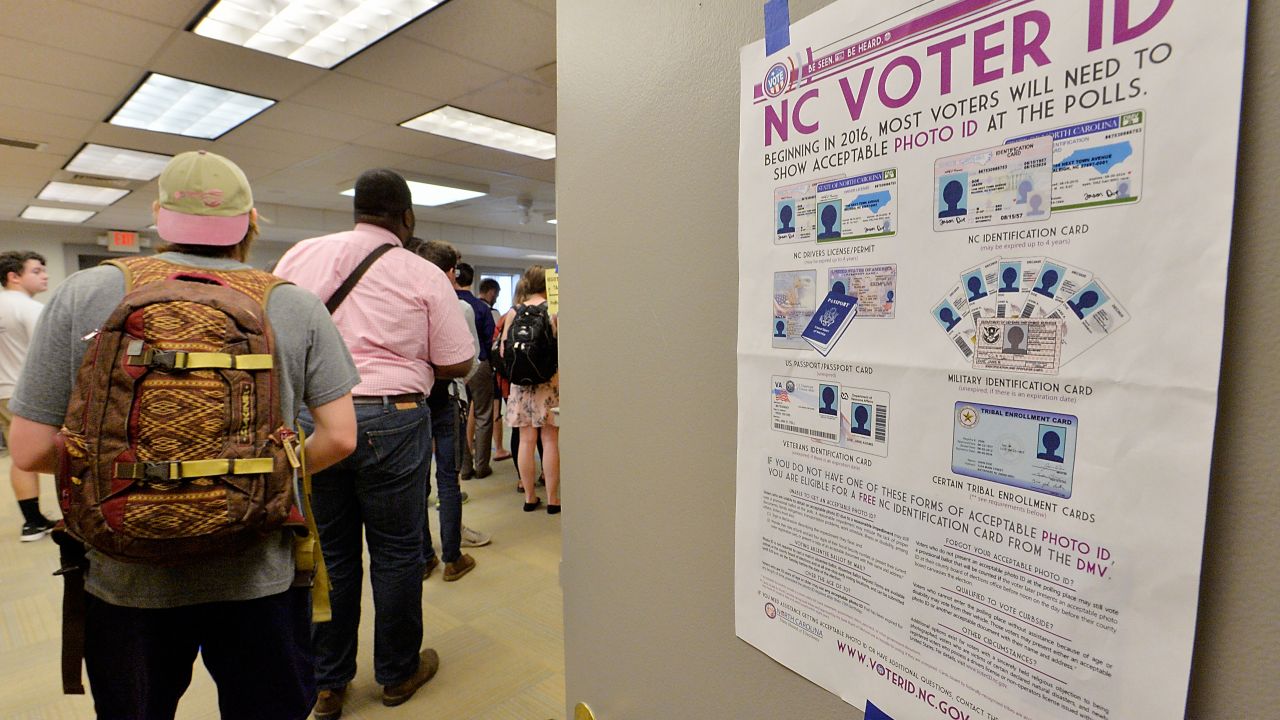
North Carolina State University students wait in line to vote in the primaries at Pullen Community Center on March 15, 2016 in Raleigh, North Carolina. (Photo by Sara D. Davis/Getty Images )
As Donald Trump enmeshed himself in a bitter fight with the parents of an American Muslim military hero — and Paul Ryan, Mitch McConnell and John McCain looked to put distance between themselves and their party’s presidential nominee — there’s actually worse news for Republicans.
Several important court victories for voting rights since Friday could dramatically remake the campaign for Congress and the White House, and this time, GOP leadership may have a harder time distancing themselves from un-American tactics.
— Judge James Peterson
When an outraged 4th Circuit Court struck down several North Carolina voting restrictions on Friday — including a stringent voter-ID provision, tough limits on early voting and an end to same-day registration — the panel of federal judges wrote that these “new provisions target African-Americans with almost surgical precision.” The judges stopped just short of calling the Republican legislators who crafted the laws racist, but condemned the racist result in unusually direct language. “We cannot ignore the record evidence that, because of race, the legislature enacted one of the largest restrictions of the franchise in modern North Carolina history.”
Meanwhile in Wisconsin, a federal judge issued a similar ruling Friday and struck a similarly appalled tone as he invalidated several recent efforts by the state legislature to tighten voter-ID requirements, limit absentee voting and shorten the windows for early voting. Judge James Peterson called the provisions a “wretched failure,” and ruled, “A preoccupation with mostly phantom election fraud leads to real incidents of disenfranchisement.”
These judges — as well as those who knocked down similarly restrictive provisions in Kansas and Texas in recent days — might well have been ruling on the GOP’s very electoral strategy this decade. It is a concerted effort to grab control of state legislatures and the House of Representatives by the minority party — and it has been staggeringly effective.
First, Republicans used their big win in 2010 to radically gerrymander the House of Representatives and state legislatures nationwide during the decennial redistricting, using dark money and cutting-edge mapmaking technology to create a majority of districts that were whiter and more conservative, even as America as a whole becomes less white and less conservative.
Then these gerrymandered legislatures — unearned supermajorities in states like North Carolina, Ohio and Wisconsin, for example, where Republicans drew such effective and unbeatable lines that they took veto-proof control of chambers despite winning fewer overall votes — pushed for new laws designed to make it even harder for minorities to vote and, ultimately, for Democrats to win.
In states like Wisconsin, maps were drawn by strategists like Tad Ottman, who sent top-secret emails to fellow partisans outlining how “we have an opportunity and an obligation to draw these maps that Republicans haven’t had in decades.” When districts are drawn with partisan intent and the desire to suppress competition, they naturally elect legislators who might then favor voter-ID laws. There is a direct line between districts drawn to minimize the effectiveness of the minority vote around Milwaukee. Judge Peterson’s finding last week that the partisan intent in drawing districts, which led to a Republican-majority legislature that enacted the voter-ID rules and other restrictive measures, had the “immediate goal” of achieving a “partisan objective, but the means of achieving that objective was to suppress the reliably Democratic vote of Milwaukee’s African-Americans.”
It is no coincidence that 17 states have enacted new voting restrictions just in time for the 2016 presidential election — or that 22 states have toughened access to the ballot box since 2010. Here are those 17 states: Alabama, Arizona, Georgia, Indiana, Kansas, Mississippi, Nebraska, New Hampshire, North Carolina, North Dakota, Ohio, Rhode Island, South Carolina, Tennessee, Texas, Virginia and Wisconsin.
It’s also no coincidence that 16 of these 17 states (save only Rhode Island) have legislatures that are dominated entirely by Republicans. NYU’s Brennan Center for Justice calls this “part of a broader movement to curtail voting rights, which began after the 2010 election, when state lawmakers nationwide started introducing hundreds of harsh measures making it harder to vote.”
In North Carolina — home to perhaps the most gerrymandered legislature in America — the judges were even more emphatic as they connected the dots between the GOP-implemented voter-ID laws and the desire on behalf of Republicans to tamp down the turnout of minority voters unlikely to cast ballots for conservatives. Their ruling painstakingly dismisses any problem with voter fraud in North Carolina, and compiles voluminous evidence that “the ‘problem’ the majority in the General Assembly sought to remedy was emerging support for the minority party.” The legislature, according to the ruling, “unmistakably” sought to “entrench itself” by “targeting voters who, based on race, were unlikely to vote for the majority party.”
It did not have to be this way. Republicans did consider another road: Dialogue and persuasion. After Barack Obama defeated Mitt Romney in 2012 — the fifth presidential election in the last six in which the Republicans were swamped in the popular vote — GOP chairman Reince Preibus commissioned an unusually frank analysis of his party’s ailments. The prognosis looked grim, according to the Growth and Opportunity Project report — more popularly known as the “GOP autopsy” — but there was a path forward: Republicans had to start listening to minority voters if they wanted a base broader than aging white men.
African-Americans and other minorities, the autopsy concluded, feared that “Republicans do not like them or want them in the country.” That wasn’t the only bitter news. The report also noted that public perception of the GOP was at “record lows,” that the party was “marginalizing itself” and that young voters were “increasingly rolling their eyes” at so-called Republican values.
Unfortunately for Republicans, this autopsy was dead on arrival. Its very sensible conclusions — champion comprehensive immigration reform, listen to and embrace the pocketbook concerns of low-income voters and ethnic minorities — found no constituency within the party. Indeed, Republican leaders had already settled on a very different plan which involved doubling down on the aging white base: Draw lines ensuring bright-red districts, then make it as hard as possible for Democrats and minorities to vote.
Now, in the last two weeks, the GOP’s crafty and cynical strategy of both remapping America’s legislative districts and suppressing minority votes officially imploded. Republicans remain overwhelming favorites to retain the House for the rest of the decade. But suppressing the minority vote in 2020 — a presidential election year when more Democrats turn out, and also the next key year for redistricting — was essential to the GOP strategy of holding on to these gerrymandered gains for another decade.
Democrats still have to win, state by state, a majority of seats in districts algorithmically determined to ensure their defeat. That already uphill task, however, seems slightly less Herculean when these voter-ID bills are systematically thrown out by courts and seen for what they are: One party standing in front of the polls and trying to block minorities from exercising their most basic and essential American right to vote.




